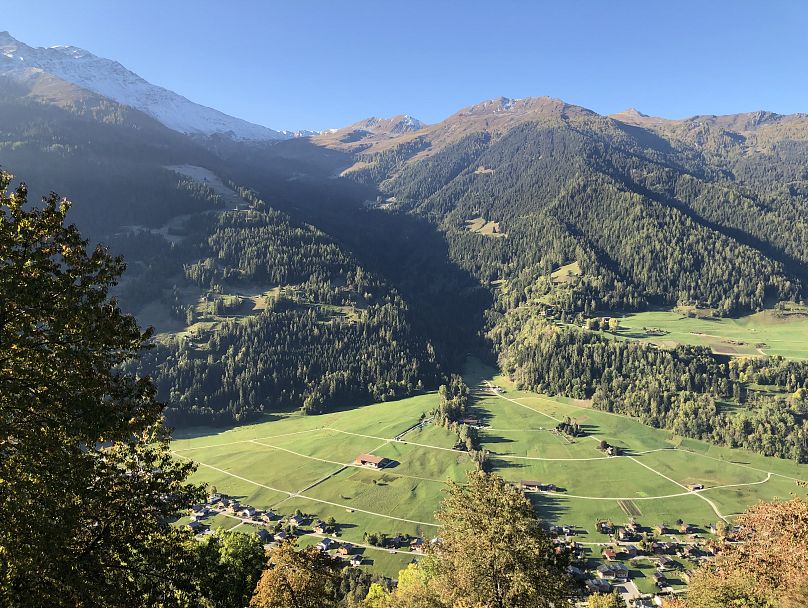I don’t like absinthe so I went to Switzerland to learn more about it and to have a go at making my own.
I’ve always been fond of an alcohol-based day out (family holidays often consisted of visits to breweries or whisky distilleries) but absinthe scared me a bit.
I don’t tend to like anything with an aniseed-like flavour and my days of drinking anything close to a neat spirit feel firmly in the past. But when the opportunity arose to visit a distillery and learn more about the infamous Green Fairy, I decided to give it a go.
Early one morning whilst staying in Verbier, Switzerland we took a trip 8km further along the Val de Bagnes to the small village of Sarreyer.
We met Matthieu at his home-based distillery, Edelweiss Distillery just outside the village. Before I tell you anything else, I must try to explain to you quite how beautiful the view is from the distillery. In fact, everywhere is beautiful in this valley so even if you have no interest in alcohol or distilling, it’s worth a visit.
As we walked along the track towards the distillery, Matthieu pointed out what most people, frankly, would have dismissed as lots of weeds - but was in fact, his herb garden.
Matthieu’s distilling philosophy is that he only uses ingredients that grow naturally in this region. So, for instance, he’ll never produce a tequila or anything orange flavoured.
In the herb garden, there were some of the classics you’ll be familiar with like mint and lemon balm. But also many more unusual but equally delightful botanicals. One of my favourites was salvia, part of the sage family, which had sweet but zingy smelling flowers.
Learning what absinthe tastes like
Once we’d had a tour of the hillside farm turned distillery, we all piled into Matthieu’s cosy kitchen - a welcome break from the cold day outside. Here started a quick lesson on the history of absinthe and, of course, the all important tasting.
Matthieu offers absinthe tasting at the Café du Mont Fort, a restaurant and community hub in the centre of Sarreyer.
Matthieu showed us the two ways to prepare absinthe - one where you burn the sugar and one where you don’t.
The one with the more caramelised flavour went down more easily, though I wouldn’t go as far as saying I enjoyed it. I should also add, this was at 10:45am.
Once the tasting was finished, it was time to have a go at making our own.
How to make absinthe
According to Matthieu, the absinthe he sells contains a combination of 35 botanicals (KFC eat your heart out!) but as we were beginners, we made a simpler recipe.
We weighed out all the ingredients, ground them as fine as possible (the stalks proved a bit tricky) and then divided the mixture evenly into the bottles. Then we added a small dollop of honey and the grape-based spirit.
With the stopper firmly fitted, I packed the bottle carefully into my suitcase (and prayed for gentle baggage handlers), ready for the journey home.
Ready, steady, sieve
For the first few days, the flavours were infusing into the alcohol. This was an unappealing sight, as the different ingredients floated to the surface creating a murky liquid.
Matthieu had advised us that the absinthe should infuse for precisely 5 days. Anything less and it wouldn’t have enough flavour, anything more and it would become bitter.
I had a few more stops to make on my journey back from Switzerland. After a flight and several trains, by day 5 I was back home and my absinthe was ready to be sieved.
Before straining, it smelled strong but surprisingly minty and not too aniseed-y (a bonus for me). After straining it wasn’t the bright green that you’d expect from a shop-bought absinthe but was somewhat less murky than before filtering.
A coffee filter probably would have done a better job than a tea strainer, but I improvised with what I have in my kitchen.
I ruminated for several days about whether I should try it, knowing I’d ultimately probably hate it. Or whether to choose my least favourite family member to gift it to for Christmas.
In the end, I decided that after all my work, it would be a shame not to taste the final product.
The taste test
My homemade absinthe turned out to be a khaki colour. Matthieu had advised that we drink it with some sugar water and to my delight, when mixed, it transformed into a lovely, fresh green colour.
After my first sip I thought, “You know what, this isn’t so bad.” It wasn’t too aniseedy, it had a light mint flavour and it was warming. Different flavours kept coming for a while, including a rather boozy kick. But overall it wasn’t bad.
I’m not going to say that I loved it, and it certainly didn’t improve the more I drank. But it wasn’t as horrible as I’d prepared myself for it to be.
Luckily, my dad gladly volunteered to finish off the glass I’d poured for myself.
Recipe for homemade absinthe
While I go for a lie down, if you want to have a go at making some absinthe yourself, here’s the recipe we used:
1 litre of base spirit
2g dried wormwood
40g green aniseed
20g fennel seed
4g dried hyssop
4g dried lemon balm
4g dried mint
3g coriander seed
2g mugwort
1g angelica seed
1g pepper
0.5g licorice root
2 whole star anise
Zest of ¼ lemon
Small dollop of honey
Grind all the botanicals together as finely as possible, add the honey and mix with the spirit base.
You can also add some extra floral botanicals according to your taste - we added some rose petals!
Leave to infuse for 5 days and then filter. Serve diluted with sugar water and enjoy!
Watch the video above to see more of Hannah’s absinthe experience.












